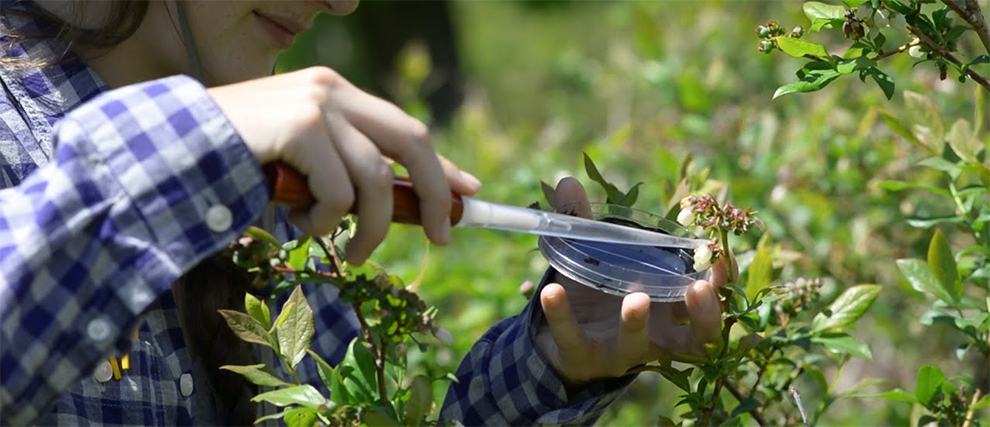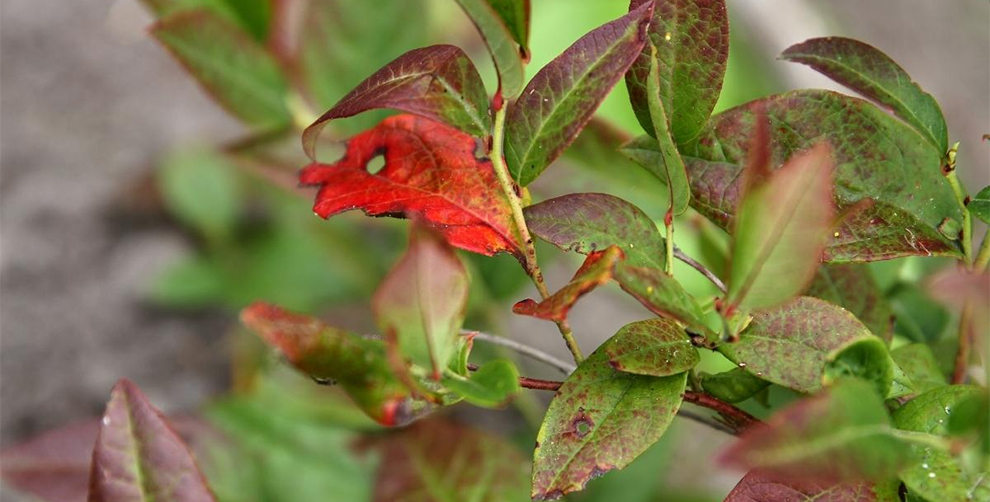How To Take Care Of Blueberry Bushes (New & Mature)
To care for blueberry bushes, grow them in acidic, well-drained soil and full sun. Mulch to conserve moisture and suppress weeds. Prune annually, water regularly, and fertilize with an acid-loving plant fertilizer.

Blueberry bushes demand diligent care to thrive and yield a bountiful harvest of delicious fruits. This guide will take you through the primary care areas necessary for maintaining healthy blueberry bushes.
So, how to care for blueberry bushes? When to water them? Do you feed them? Let’s get answers to all these questions.
First things first. The location of your blueberry bushes has a crucial role in their success. So, pick a sunny spot receiving at least six hours of direct sun daily. Further, blueberries love rich acidic soil, deep watering once or twice weekly, and mulch to eliminate weeds.
Apply an acidic, balanced plant food in early spring and again in early summer or late spring, following the packaging instructions.
Pruning the blueberry bushes during the dormant season, especially in early spring or late winter, helps. To ensure your blueberry bushes’ health, be vigilant against diseases and pests.
Further, regularly inspect for common pests, like fruit flies, mites, and aphids. Use organic insecticides whenever necessary, and watch out for diseases like mummy berries and powdery mildew, promptly treating them with suitable fungicides.
You can foster beautiful blueberry bushes that yield an abundant crop of delectable fruits by focusing on these crucial care aspects.
How To Take Care Of Blueberry Bushes?
After planting blueberry bushes, you must give them some ongoing care that comprises maintaining soil acidity within the range of 4.0 and 5.5. Further, regularly pruning to remove damaged or dead branches, promoting air circulation, and offering adequate moisture via deep watering.
Here are some vital tips for caring for your blueberry bushes.
A. How do I prepare my soil for blueberries?
Blueberry bushes have specific soil requirements to thrive. They cherish acidic soils with a pH between 4.0 and 5.5. Hence, it is imperative to test the soil and make adjustments using amendments like peat moss or elemental sulfur.
Further, blueberries thrive in well-draining soil rich in organic matter. So, incorporating well-rotted pine bark or compost into the soil can help better the structure, fertility, and moisture retention abilities.
B. Can blueberry bushes grow in shade?
No. Blueberry bushes demand ample sun to grow and produce abundant fruits. They thrive in full sun, meaning they need at least six to eight hours of direct sun daily.
Hence, plant the blueberry bushes in a spot that receives maximum sun exposure for optimal fruit production and promoting vigorous growth.
C. How frequently should you water a blueberry bush?
Proper watering is imperative for the productivity and health of your blueberry bushes. These plants seek consistent moisture, typically during the fruit development stage. Here are some factors to bear in mind when watering the blueberry bushes.
1. Deep watering: Blueberry bushes need deep watering to ensure the water enters the root zones. A thorough, slow watering once or twice a week typically suffices. It is best to avoid shallow and frequent watering, as they may result in weak root growth.
2. Moisture monitoring: Regularly inspect the soil moisture level around the bushes. Blueberry bushes thrive in evenly moist soil. However, the soil must not be waterlogged. You can use a moisture meter or finger to assess the moisture content and alter the watering frequency accordingly.
3. Mulching: Apply a mulching layer to help retain moisture in the soil and reduce evaporation.
4. Soaker hoses or drip irrigation: Employ soaker hoses or drip irrigation to deliver the water directly to the bushes’ root zones. This method helps conserve water and ensure efficient delivery sans wetting the foliage.
5. Rainwater collection: Collect and employ rainwater for watering the blueberry bushes. Rainwater is usually bereft of any chemical, and its natural pH suits blueberries’ acidic soil preferences.
D. What is the best fertilizer for blueberry bushes?
Feeding blueberry bushes is imperative to provide them with the necessary nutrients for optimal fruit production and healthy growth. Always pick a fertilizer meant for acid-loving plants containing sulfur or ammonium sulfate.
Here are some tips when feeding the blueberry bushes:
1. Timing: Blueberries like fertilization in early spring before the new growth emerges and again in early summer or late spring. This timing helps the plant to employ the nutrients during the active growing season.
2. Acidic feeding: Blueberries have specific nutrient requirements and do best in acidic soil conditions. Hence, it is imperative to employ a plant food exquisitely formulated for acid-loving plants. Shop for blueberry bush fertilizers labeled for acid-loving plants or blueberries, typically with sulfur-coated urea or ammonium sulfate. These plant foods give your blueberries vital nutrients and help maintain the desired acidity level.
3. Application rate: Always read the instructions on the packaging label to know the recommended application rate. The feeding needs for your blueberry bushes vary depending on their size and age.
4. Application method: Spread the fertilizer around the base, starting a few inches away from the trunk and extending to the drip line. Please do not place the plant food directly against the trunk. It may cause damage.
5. Watering: Once you apply the fertilizer, water the bushes thoroughly. It helps dissolve and distribute the nutrients into the soil, making them accessible to the roots.
6. Organic alternatives: If you prefer organic options, consider foods formulated for acid-loving plants or natural amendments like composted pine bark or coffee grounds. These offer your plants slow-release nutrients and help better soil health over time.
Do I Need To Prune Blueberry Bushes? If Yes, How and When?
Pruning blueberry bushes is vital for plant health, promoting better fruit production, and shaping the bushes. Here are some tips to follow:
- Prune blueberry bushes during late winter or early spring while dormant before new growth begins.
- Remove dead, damaged, or diseased branches.
- Thin out overcrowded bushes to improve air circulation and light penetration.
- Shape the bushes by trimming excessively long branches and aiming for an open center.
- Consider more aggressive pruning for older bushes to rejuvenate growth.
- Use clean, sharp pruning tools to make clean cuts.
- Apply organic mulch after pruning to retain moisture and suppress weeds.
Is Repotting Needed by Blueberry Bushes At Any Point?
Be it any type of blueberry bushes, they do not need frequent repotting like other container plants. But in some situations, repotting can be beneficial or necessary for the blueberry bushes. These include:
1. Outgrowing the pot: If your bushes outgrow the current pots, you must repot them into larger containers. It gives the roots ample space for continued growth.
2. Soil renewal: Over time, the container or ground soil runs out of nutrients or loses its ideal pH. In this case, amending the soil or repotting can help give the plants a nutrient-rich, fresh substrate to maintain the soil acidity.
3. Rejuvenation: When your older blueberry bush exhibits poor growth or weakens, repot them into fresh soil with proper amendments to rejuvenate the plant and promote growth.
While repotting, consider the tips below to extend the lifespan of your blueberry bushes:
- Pick a planting location or container with adequate space for the roots to spread comfortably.
- Use a well-draining soil mix ideal for blueberries, ensuring it is acidic and rich in organic matter.
- Remove the plant from its current container carefully or dig the root ball if planted in the ground without damaging the roots.
- Insert the blueberry bush in the new container or planting hole, maintaining the same depth as before.
- Backfill the hole or container with fresh soil mix, gently firming it around the roots sans excessive compaction.
- Water the repotted bush well to allow the soil to settle and eliminate air pockets.
How To Care For New Blueberry Bushes – Is Blueberry Bush Care In The First Year Any Special?
Yes. Caring for the new blueberry bushes in their first year demands special attention, as it is the time when they establish healthy growth and strong roots. Here are some considerations for your new blueberry bushes:
1. Watering: Proper watering is imperative in the first year. Keep the soil consistently moist, not waterlogged. Water regularly and deeply in the dry periods. It helps ensure the roots get ample moisture.
2. Mulching
Apply an organic mulch layer. It can help the new plants retain moisture, regulate soil temperature, and keep weeds away.
3. Soil preparation: Before planting, prep the soil by incorporating organic matter like well-rotted pine bark or compost to boost fertility and drainage. The pH must be between 4.0 and 5.5 for optimal growth.
4. Feeding: Blueberry bushes do not need heavy feeding in the first year. So, consider using acidifying, balanced plant food. Follow the package instructions to avoid overfeeding the bushes.
5. Pruning: In the first year, your plant needs minimal pruning. But it is good to remove any damaged or dead branches. However, please do not indulge in heavy pruning. It can hinder fruit production and growth.
6. Guard against pests: Monitor your plants for pests like mites and aphids and take action as needed. Practicing natural pest control methods and employing organic insecticides help guard the new plants from damage.
7. Winter protection: Those who reside in areas with harsh winters must guard their young blueberries by covering them with a thick mulch layer or burlap around the base to insulate the roots.
8. Be patient and watchful with your new blueberry bushes, and give them adequate time to establish themselves. Regularly monitor the roots for signs of pests, stress, and diseases, and make amends as needed.
How To Care For A Blueberry Bush In A Pot?
Caring for the blueberry bush in the pot follows the same principles as caring for the one planted in the ground, with a few additional considerations. Here is a quick summary:
- Pick a large container with good drainage and sufficient space for root growth.
- Use an acidic potting mixture exquisitely formulated for blueberries.
- Keep the pot in a sunny spot with ample airflow.
- Water regularly, leaving the soil moist, not waterlogged.
- Apply an organic mulch around the plant’s base to retain moisture and regulate soil temperature.
- Offer regular feeding with acidic plant food.
- Prune as required to maintain shape and remove damaged or dead branches.
- Monitor for pests and diseases, and take measures if needed.
- Consider repotting every few years to offer room for root growth and give the plant fresh soil.
How To Take Care Of Blueberry Bushes In The Winter?
Winter care for blueberry bushes demands specific consideration to guard them against harsh conditions. For this, follow the steps:
- Apply an organic mulch layer to insulate the roots and retain moisture in late fall.
- Reduce watering but ensure ample soil moisture.
- Remove damaged, dead, and diseased branches during the dormant season.
- Use covers like burlap or frost blankets to guard the bushes from extreme weather.
- Check for pests and diseases and take preventive measures.
- Regularly inspect for winter damage and prune affected areas.
Beyond these winter care practices, the blueberry bushes’ routine care requirements remain the same as discussed above.
How To Care For Blueberry Bushes In The Fall?

During fall, the blueberry bushes care routine has a few specific requirements, whereas the other things remain the same. Here is what you need to do:
- Pick ripe berries gently to avoid damaging the branches.
- Conduct minor pruning to remove diseased, dead, or damaged branches.
- Remove fallen berries, leaves, and debris to minimize disease and pest attacks.
- Apply a mulching layer around the base for moisture conservation and weed suppression.
- Cover the bushes with frost blankets or burlap in extremely cold regions.
How Do You Care For Blueberry Bushes In Spring?
Here is a quick summary of blueberry bush spring care:
- Apply a balanced, slow-release fertilizer formulated for blueberries in early spring to support healthy growth and fruit development.
- Monitor for pests and diseases, and take appropriate measures to prevent or address any issues that may arise.
- While you do significant pruning in late winter or early spring, you can perform light pruning to shape the bushes and remove any remaining dead or damaged branches.
- Monitor for new growth to ensure healthy development and address any signs of nutrient deficiencies or other problems.
- Check soil moisture levels and adjust watering, if needed, to ensure consistent moisture, especially during dry spells.
Blueberry Bush Problems

Some common problems linked to your blueberry bushes are as follows:
- Blueberries can be susceptible to pests like fruit flies, aphids, mites, and caterpillars. Monitor regularly and take apt pest control measures to manage infestations.
- Blueberry dishes may encounter diseases like botrytis blight, root rot, or powdery mildew. Good air circulation, proper sanitation, and fungicide treatments can help manage these diseases.
- Blueberry bushes may show nutrient deficiency symptoms like stunted growth and yellowing leaves. Targeted feeding and soil testing can help address nutrient imbalances.
- Improper pollination may result in poor berry development and reduced fruit set. Encourage pollinators and grow different flowering plants nearby to better pollination success.
- Extreme weather conditions like drought, heatwaves, and frost can stress the blueberry bushes. Mulching, adequate irrigation, and protection from temperature extremes can help mitigate these stressors.
